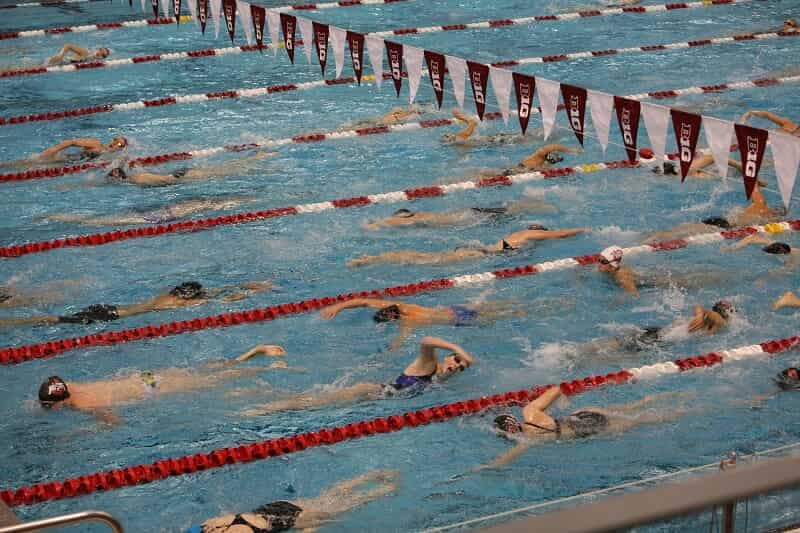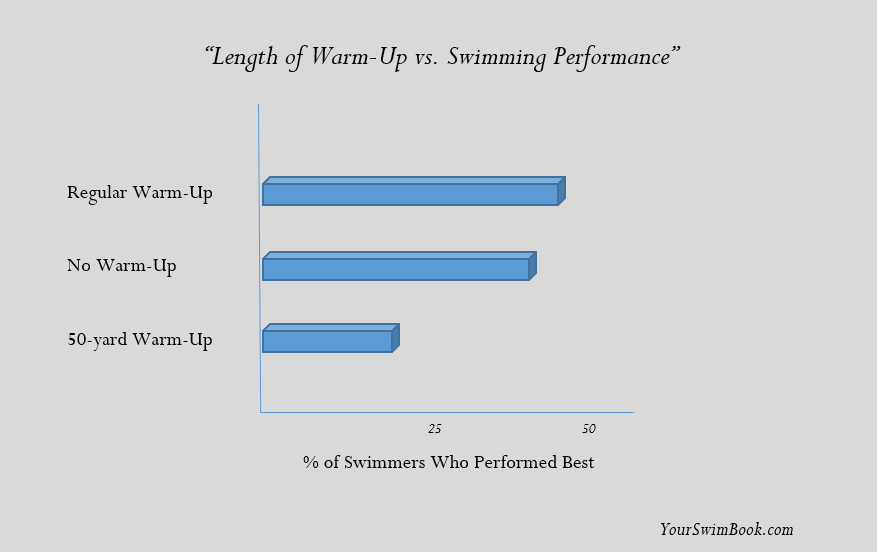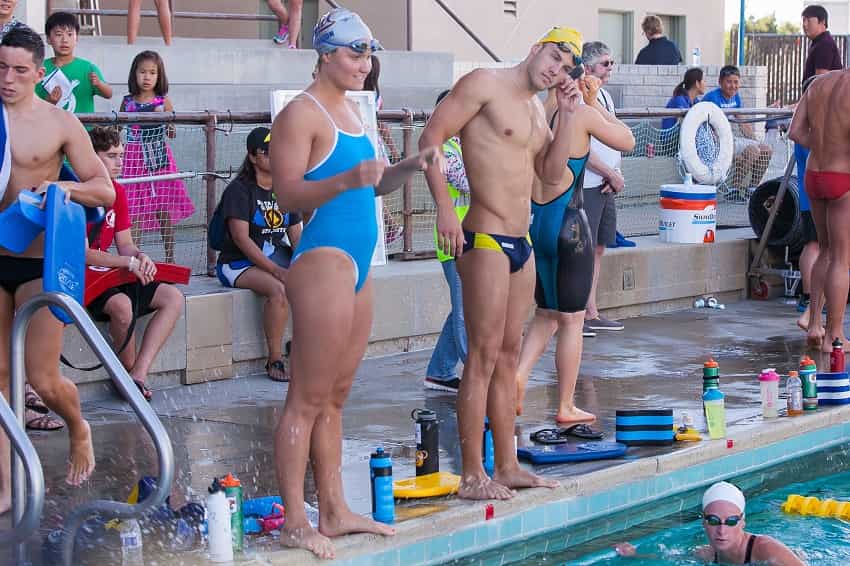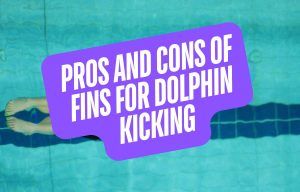From the science behind it, what you should do if the water is too crowded, to best practices for fast swimming, here is everything you ever wanted to know about the swim meet warm-up.
“Did you warm-up?” asks coach, an eyebrow raised.
“Umm, yes,” you say sheepishly, wondering how much of your warm-up he watched.
Maybe he saw you bobbing at the wall for half the warm-up, trying to fit in between swimmers. Or perhaps he saw you get kicked by the breaststroker and hang off the lane line for a few more minutes. Or the self-styled speedster who did a flip-turn on you even though you were in the corner of the lane.
You resign yourself to knowing that you didn’t really warm-up the way you want to, and you carry this little nugget of negativity with you for the rest of the session, knowing that your swims will have a little asterisk beside them…
If only I’d been able to properly warm-up…
Look, we both know that…
Swim meet warm-ups are always a complete and utter gong-show.

Arms, ankles, and capped-heads bubbling in the water. Line-ups around the corner to use the blocks. Bodies littered across the walls, lane ropes and everywhere in between.
Whoever said swimming wasn’t a contact sport never tried splitting a 25-yard lane with 35 other swimmers all doing completely different strokes at wildly different speeds.
So some swimmers retreat to the hot tub. Or to do arm swings in the showers. Or hop into the kiddie pool and do a couple minutes of doggie paddle and wall kick.
But as it turns out, warming up is more important than you realize.
 The Science Behind an Awesome Warm-Up
The Science Behind an Awesome Warm-Up
While you probably know that warming up is a good idea (it’s been drilled into you since your first organized swim practice, after all), do you know why it’s actually done?
Warming up gets your body to swim fast in a few different ways:
1. It raises core and body temperature. Heightened body temperature decreases the viscous resistance of muscles and joints, making your arms and legs more pliable and increase range of motion. [1]
2. Fires up your nervous system. This is where you regain your feel for the water, and also primes the fast twitch stuff (hence why coach has you do a couple sprints towards the end of your meet warm-up). Warming up has been shown to improve nerve conduction rate and also speeds up metabolic reactions (phosphate degradation in particular). [2]
3. Warms up your lungs. Ever noticed that when you first get in the water you can barely hold your breath long enough to do more than a couple dolphin kicks off each wall? And that by the end of warm-up you can destroy your walls no problem? Your warm-up also acts as a respiratory warm-up, helping you avoid gasping for breath like an amateur during your races later in the session. [3]
4. Increases oxygen delivery. Oxygen is the fuel of our swimming . We can only go so long without oxygen before our performance declines and we eventually, like, die and stuff. A nice little warm-up has been shown to increase oxygen delivery to muscles. [4]
How Long Should Swimmers Warm-Up For?
We all have that warm-up that we lean on (or at least we should) when we go to competition. We know that no matter how we are feeling, or what is going on outside the pool, that we can do our template warm-up and be ready to race.
A study done with a group of group of NCAA swimmers had them do three different warm-ups:
- No warm-up.
- A warm-up consisting of a 50-yard swim at 40% intensity.
- A typical pre-race warm-up.
The results?
44% of the swimmers performed best after a regular warm-up, 19% after the 50-yard swim at 40% intensity, and most interestingly, 37% after no warm-up.

So the takeaway? That you can still bang out a good swim even if you aren’t able to get any warm-up done in the pool.
Further, there was no real difference in reaction time, distance off the blocks, stroke count or perceived rate of exertion among the three types of warm-up.
Does this mean you should dive in with completely cold muscles and perform full blast efforts?
Absolutely not.
One summer, under the thinking that I needed to be able to swim fast no matter what the circumstances, I did a couple arm swings, dove in and blasted out a 50 freestyle, promptly tearing an intercostal muscle in my rib cage.
Any kind of sneezing, coughing and laughing promptly became my proverbial nightmare.
You wouldn’t stomp the gas on your car after it had been sitting in the cold all weekend, so don’t do the same thing with your body.
Loosen and warm yourself up in some form or shape, regardless of how much or how little pool space you have on your hands.
How Much Time Before Your Race Should You Warm-Up?
The good news is that if you are competing later in the session you can get away with warming up outside of the scheduled warm-up hours and thereby avoid the maelstrom (provided they have a secondary pool for this purpose, obviously).
In one study of internationally ranked swimmers they were instructed to perform a 200m time trial. One group was given 20 minutes between warm-up and race time, and the other was given 45 minutes. The 20-minute group swam 1.5% faster, most likely due to “better core temperature maintenance.”
Knowing this can be helpful for timing your warm-ups, and if you are swimming multiple events spread out over the course of a long session this info provides the impetus to plan for a couple mini warm-ups to keep yourself loose and warm.
SEE ALSO: How to Warm Up for Fast Swimming in Practice
How to Supercharge Your Swim Meet Warm-Up:
Here are a few sneaky ways that you can help prime your body for fast swimming before and during your warm-up:
1. Visualize your race/big efforts in the minutes leading up to it.
One of my favorite ways to get warmed up is to stand behind the block of the lane I am going to swim in later and mentally rehearse the race a couple times. I imagine the dive, how the water feels, the kick tempo.
I liked to do this before warm-up to make it as much a rehearsal as possible, so that when I dove in later it felt like I had already been there.
2. Prime your central nervous system.
Your body should be ready to go before you dive in the water. Don’t use the first lap of your race to acclimatize yourself to swimming at top speed.
How can you do this?
Do some explosive movements outside of the pool that simulate your race. A couple squat jumps. Some fast-paced push-ups. Medicine ball throw downs. Just a handful of reps—the point isn’t fatigue but CNS stimulation.
3. Swim until you are ready.
Once you feel like you are ready to rock and roll, your warm-up is done. No need to belt out a 3,000m warm-up/workout because you feel so great in the water that you end up taxing yourself.
4. Have a Plan B warm-up.
If you know that the meet warm-up is going to be a nightmare, and there is no secondary pool, develop a dryland warm-up with your coach.
You’ll still want to get a few laps in to get that feel for the water, but if you can manage the majority of your warming up outside of the pool the less likelihood you run of getting booted in the face by that jerk breaststroker.
Develop a plan in the weeks leading up to the meet (and use it before your regular swim practices to get a feel for it).
5. Stay warm between races.
Choosing the perfect parka for swimmers helps you stay warm between races, dry off after swim practice, and store your swim gear on race day, from spare swim goggles to headphones for listening to music to get psyched up.
The classic swimmer’s parka has been a common sight on deck at swim meets for as long as I can remember, and with good reason—getting bundled up helps keep that core temperature raised.
Throw on some sweat pants, a hoodie/parka and preserve some of the heat you built up during your warm-up.
In Summary
As you get older and more experienced you will learn what works best for you not only physically, but mentally in terms of getting prepared to swim lights-out.
Stay loose, stay warm, stay ready.
Image Credit: Ruth E. Hendricks Photography














